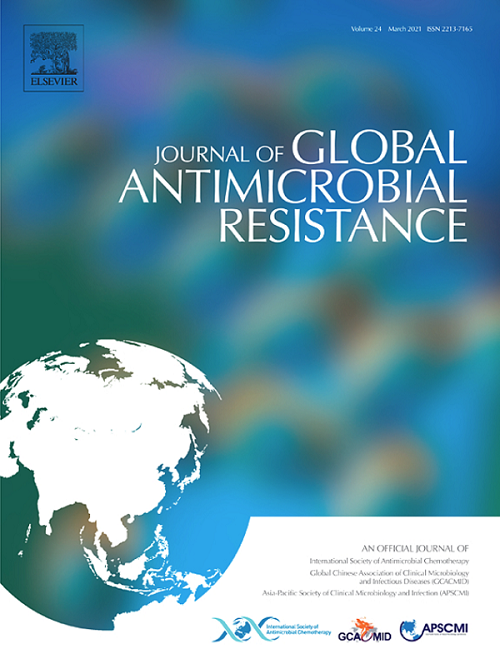泰国北部临床和监测样本中耐万古霉素屎肠球菌的基因型和表型特征
IF 3.2
3区 医学
Q2 INFECTIOUS DISEASES
引用次数: 0
摘要
目的:万古霉素耐药屎肠球菌(VREfm)因其耐多药、环境持久性和高传播性而成为医院获得性感染的重要原因。本研究旨在通过检测抗微生物药物耐药性、毒力基因分布、生物膜形成和遗传背景来表征临床和监测VREfm分离株。方法:清迈医院收集VREfm分离株107株(临床43株,监测64株)。进行了药敏试验、耐药和毒力基因PCR检测以及结晶紫法生物膜的形成。对4个有代表性的分离株进行了全基因组测序。结果:大多数临床分离株(88.4%)来自尿液样本,而所有监测分离株均来自直肠拭子。大多数患者(74-75%)年龄在60岁以上。所有的分离株都对氨苄西林、青霉素、环丙沙星、左氧氟沙星和万古霉素耐药,其中一些表现出高度的庆大霉素耐药。所有分离株均检测到vanA基因,对应万古霉素mic≥64µg/mL。在96.9 ~ 100%的分离菌中检出毒力基因,如hyl、acm和sagA。83.7%的临床分离株和68.7%的监测分离株出现中度生物膜形成,特别是携带多种毒力基因的分离株。WGS鉴定出两种序列类型;ST17和ST262具有相似的耐药性和毒力特征。结论:临床和监测分离的VREfm具有相当的耐药性和毒力特征。这些研究结果强调需要持续监测医院,特别是高危人群的VREfm,以预防感染和改进治疗策略。本文章由计算机程序翻译,如有差异,请以英文原文为准。
Genotypic and phenotypic characterization of vancomycin-resistant enterococcus faecium from clinical and surveillance samples in northern Thailand
Objectives
Vancomycin-resistant Enterococcus faecium (VREfm) is a significant cause of hospital-acquired infections due to its multidrug resistance, environmental persistence, and high transmissibility. This study aimed to characterize clinical and surveillance VREfm isolates by examining antimicrobial resistance profiles, virulence gene distribution, biofilm formation, and genetic background.
Methods
A total of 107 VREfm isolates (43 clinical, 64 surveillance) were collected from Maharaj Nakorn Chiang Mai Hospital. Antimicrobial susceptibility testing, PCR detection of resistance and virulence genes, and biofilm formation using the crystal violet assay were performed. Whole genome sequencing (WGS) was conducted on four representative isolates.
Results
Most clinical isolates (88.4%) were from urine samples, while all surveillance isolates were obtained from rectal swabs. The majority of patients (74–75%) were over 60 years old. All isolates exhibited resistance to ampicillin, penicillin, ciprofloxacin, levofloxacin, and vancomycin, with some showing high-level gentamicin resistance. The vanA gene was detected in all isolates, corresponding with vancomycin MICs ≥64 µg/mL. Virulence genes esp, hyl, acm, and sagA were detected in 96.9–100% of isolates. Moderate biofilm formation was observed in 83.7% of clinical and 68.7% of surveillance isolates, particularly among those carrying multiple virulence genes. WGS identified two sequence types; ST17 and ST262, which shared similar resistance and virulence profiles.
Conclusions
Clinical and surveillance VREfm isolates exhibited comparable resistance and virulence characteristics. These findings underscore the need for continuous surveillance of VREfm in hospitals, particularly among high-risk populations, to prevent infections and improve treatment strategies.
求助全文
通过发布文献求助,成功后即可免费获取论文全文。
去求助
来源期刊

Journal of global antimicrobial resistance
INFECTIOUS DISEASES-PHARMACOLOGY & PHARMACY
CiteScore
8.70
自引率
2.20%
发文量
285
审稿时长
34 weeks
期刊介绍:
The Journal of Global Antimicrobial Resistance (JGAR) is a quarterly online journal run by an international Editorial Board that focuses on the global spread of antibiotic-resistant microbes.
JGAR is a dedicated journal for all professionals working in research, health care, the environment and animal infection control, aiming to track the resistance threat worldwide and provides a single voice devoted to antimicrobial resistance (AMR).
Featuring peer-reviewed and up to date research articles, reviews, short notes and hot topics JGAR covers the key topics related to antibacterial, antiviral, antifungal and antiparasitic resistance.
 求助内容:
求助内容: 应助结果提醒方式:
应助结果提醒方式:


